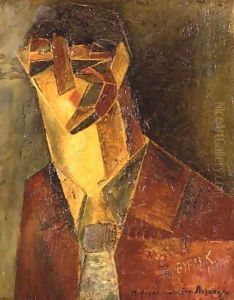Vladimir Burliuk Paintings
Vladimir Burliuk was a prominent Ukrainian-Russian artist, brother of David Burliuk, one of the founders of the Futurist movement in Russia. Born on March 27, 1886, in Kharkiv, then part of the Russian Empire, he was part of a large family with several artistic siblings, including his better-known brother David Burliuk, who was often called the 'father of Russian Futurism.'
Vladimir began his art education in Odessa and later continued at the Royal Academy in Munich before moving on to study in Paris. His travels and education in Europe allowed him to be exposed to a wide range of artistic styles, which he incorporated into his work. Burliuk's artistic style evolved over time, reflecting elements of Neo-Primitivism, Cubism, and Futurism.
In the years leading up to World War I, Vladimir Burliuk became actively involved in the Russian avant-garde movement. He contributed to exhibitions and had a significant influence on the development of Russian Futurism, both through his own works and his collaboration with other artists. Together with his brother David and other avant-garde artists, he participated in the famous 'Donkey's Tail' exhibitions, which were critical to the dissemination of modernist ideas in Russian art.
Tragically, Vladimir Burliuk's life and career were cut short by the tumultuous events of World War I. He was drafted into the Russian army and served on the front lines. In 1917, during a battle, Vladimir Burliuk was killed at the age of 31. His death was a loss to the Russian avant-garde movement, as he was among its promising talents.
Despite his brief career, Vladimir Burliuk's work was influential in the context of Russian avant-garde art, and he is remembered for his innovative approach and contribution to early 20th-century modernism. His works are held in various museum collections and continue to be studied by scholars interested in the period.
